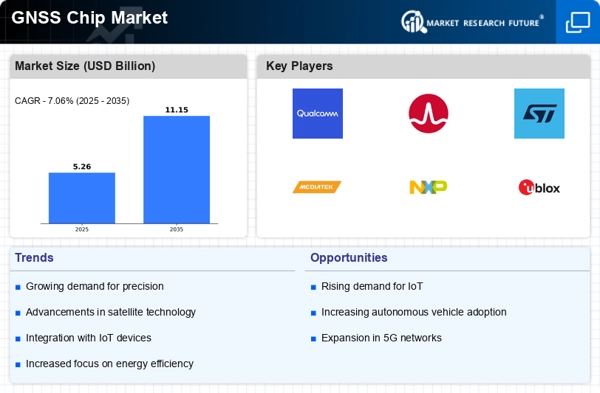Growth of Automotive Sector
The automotive sector's rapid evolution towards advanced driver-assistance systems (ADAS) and autonomous vehicles is significantly influencing the GNSS Chip Market. As vehicles increasingly incorporate GNSS technology for navigation and safety features, the market for GNSS chips is poised for substantial growth. Reports suggest that the automotive GNSS market could reach USD 30 billion by 2025, driven by the need for precise positioning and real-time data. This trend is further fueled by regulatory mandates for enhanced safety measures, compelling manufacturers to integrate GNSS solutions into their vehicles. Thus, the GNSS Chip Market stands to benefit from the automotive sector's transformation, as the demand for reliable and accurate positioning systems escalates.
Expansion of Smart City Initiatives
The ongoing development of smart city initiatives is a crucial driver for the GNSS Chip Market. As urban areas strive to enhance infrastructure, transportation, and public services, the integration of GNSS technology becomes essential. Smart city projects often rely on accurate location data for traffic management, public transportation optimization, and emergency response systems. With investments in smart city technologies projected to exceed USD 1 trillion by 2025, the demand for GNSS chips is likely to surge. This trend indicates a growing recognition of the importance of precise positioning in urban planning and management, thereby propelling the GNSS Chip Market forward as cities adopt innovative solutions to improve livability and efficiency.
Increased Adoption of Drones and UAVs
The rising adoption of drones and unmanned aerial vehicles (UAVs) is significantly impacting the GNSS Chip Market. Drones are increasingly utilized across various sectors, including agriculture, construction, and logistics, necessitating advanced GNSS technology for navigation and data collection. The drone market is expected to grow at a compound annual growth rate (CAGR) of over 20% in the coming years, highlighting the escalating demand for precise positioning systems. As UAVs require reliable GNSS chips for effective operation, the GNSS Chip Market is likely to witness substantial growth. This trend underscores the importance of accurate location data in enhancing the capabilities and applications of drones across diverse industries.
Rising Demand for Location-Based Services
The increasing reliance on location-based services is a primary driver for the GNSS Chip Market. As consumers and businesses seek enhanced navigation, tracking, and mapping solutions, the demand for GNSS chips is expected to rise. According to recent estimates, the location-based services market is projected to reach USD 100 billion by 2026, indicating a robust growth trajectory. This surge is largely attributed to the proliferation of smartphones and mobile applications that utilize GNSS technology for various functionalities, including ride-sharing, food delivery, and logistics. Consequently, the GNSS Chip Market is likely to experience heightened demand as service providers integrate advanced positioning capabilities into their offerings.
Technological Advancements in GNSS Systems
Technological advancements in GNSS systems are driving innovation within the GNSS Chip Market. The introduction of multi-frequency GNSS chips and improved signal processing techniques enhances positioning accuracy and reliability. These advancements are particularly relevant in applications requiring high precision, such as surveying, agriculture, and geospatial analysis. The market for high-precision GNSS solutions is projected to grow significantly, with estimates suggesting a value of USD 5 billion by 2025. As industries increasingly demand enhanced performance from GNSS technology, the GNSS Chip Market is likely to evolve, fostering the development of next-generation chips that meet the needs of various applications. This continuous innovation is essential for maintaining competitiveness in a rapidly changing technological landscape.
















Leave a Comment